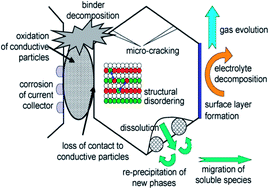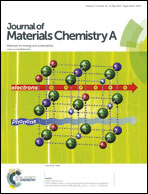Bulk and surface analyses of ageing of a 5V-NCM positive electrode material for lithium-ion batteries
Abstract
The layered transition-metal oxide xLi2MnO3·(1 − x)Li(NiaCobMn1−a−b)O2 (5V-NCM or HE-NCM) is a very promising alternative to LiCoO2 in rechargeable Li-ion batteries. However, use of this overlithiated NCM requires knowledge of its long-term stability. Tolerance to humidity is an important factor that affects the shelf life of this material. Lithiated layered compounds and, in fact, all common positive electrode materials, are hygroscopic to some degree. This property is a result of the high reactivity of Li towards H2O. In our experiments, we investigated the ageing process of 5V-NCM in a humid atmosphere via electrochemical analysis, scanning electron microscopy, infrared spectroscopy, in situ neutron diffraction, and in situ synchrotron X-ray diffraction. Exposure to a humid atmosphere led to a rapid chemical attack that manifested itself in the formation of Li2CO3 at the surface. While at C/10 practically the same specific charges were obtained for fresh and aged 5V-NCM, at 1 C the aged sample delivered only ∼70% of the specific charge of the fresh sample. Diffraction experiments showed significant differences in the evolution of the lattice parameters during the first cycle for the fresh and the aged sample. The aged sample was demonstrated to give rise to the formation of a spinel-like phase during discharge. These results suggest that ageing management of the 5V-NCM positive electrode material is essential.


 Please wait while we load your content...
Please wait while we load your content...